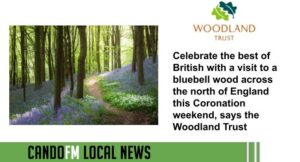
They’re a right-royal spectacle, full of pomp and majesty, and the brilliant British bluebell is blooming in woods across the north of England just in time for Saturday’s coronation.
With his love of plants well known, His Majesty King Charles III would no doubt approve of a visit to a breathtakingly beautiful bluebell wood in his honour.
And with the fragile flower at its best right now, there couldn’t be a better time to witness a truly iconic sight.
So, with that in mind, the Woodland Trust has come up with a list of some of its top bluebell woods to visit over the bank holiday weekend.
Many of the UK’s largest woodland conservation charity’s 1,000 woods are a lavender haze of delicate bluebells at this time of year, and the Trust’s citizen science database Nature’s Calendar shows that this weekend could well be prime bluebell time in your local wood.
“Our woods are glorious at any time of year, but spring bluebells really are a crowning glory and an experience not to be missed” said the Woodland Trust’s Kate Lewthwaite.
“Our Nature’s Calendar records for this spring tell us that in many parts of the UK bluebells are now in bloom and what better way to celebrate the King’s coronation than to get into the great outdoors and visit this quintessentially British sight in our woods!
“The violet glow of a bluebell site is an incredible spectacle here in the British Isles and a very precious one too – they’re often associated with ancient woodland and in combination with other species can act as an ancient woodland indicator plant. Hence If you spot it while out exploring, it could be a sign you are standing in a rare and special habitat.
“They’re also very important for wildlife too – woodland butterflies, bees and hoverflies all feed on their nectar.
“If out and about this weekend though, do remember that while the bluebell is still common throughout Britain, it is under threat locally from habitat destruction, hybridisation with non-native bluebells and the illegal trade of wild-collected bulbs. Bluebells can take years to recover from the damage caused by trampling, and if their leaves are crushed, they can be weakened (as they can no longer photosynthesise).
“So please, do get out and visit such a wonderful sight – but please admire them from the paths.”
The Trust is appealing for visitors to its bluebell woods to enjoy their natural splendour, while being careful not to destroy any flowers by sticking to proper paths and keeping dogs on leads.
Here’s some of the best bluebell woods the Woodland Trust has to offer:
North of England Longacre Wood, Cheshire Longacre Wood – Woodland Trust
Murdishaw Wood, Runcorn Murdishaw Wood – Visiting Woods – Woodland Trust
Little Swine Carr Wood, North Yorkshire Little Swine Carr Wood – Woodland Trust
Dufton Ghyll Wood, Dufton, Cumbria Dufton Ghyll Wood – Woodland Trust
Hackfall, Grewelthorpe, North Yorkshire Hackfall – Visiting Woods – Woodland Trust
Masons Wood, Preston Masons Wood – Woodland Trust
Nidd Gorge, Bilton Banks Harrogate Nidd Gorge – Visiting Woods – Woodland Trust
Sea Wood, Bardsea, Morecambe Sea Wood – Visiting Woods – Woodland Trust







